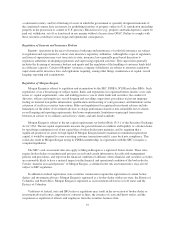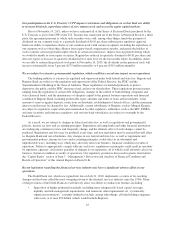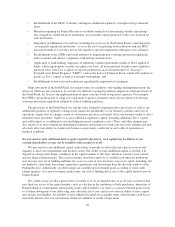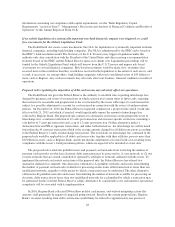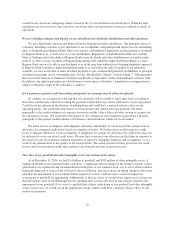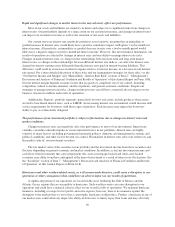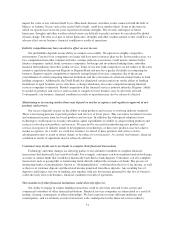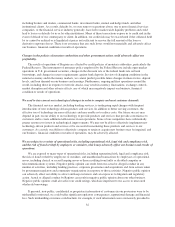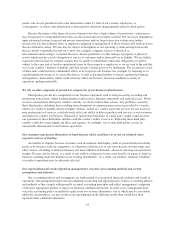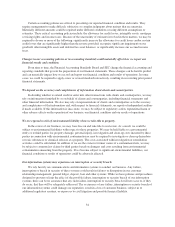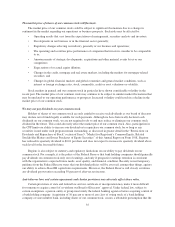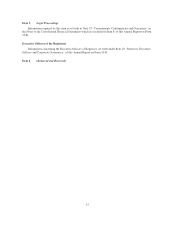Regions Bank 2010 Annual Report Download - page 43
Download and view the complete annual report
Please find page 43 of the 2010 Regions Bank annual report below. You can navigate through the pages in the report by either clicking on the pages listed below, or by using the keyword search tool below to find specific information within the annual report.current levels, absent any mitigating actions, based on the 12 cent alternative described above. While the final
regulations are not yet known, they may have an adverse effect on our business, financial condition or results of
operations.
We are a holding company and depend on our subsidiaries for dividends, distributions and other payments.
We are a legal entity separate and distinct from our banking and other subsidiaries. Our principal source of
cash flow, including cash flow to pay dividends to our stockholders and principal and interest on our outstanding
debt, is dividends from Regions Bank. There are statutory and regulatory limitations on the payment of dividends
by Regions Bank to us, as well as by us to our stockholders. Regulations of both the Federal Reserve and the
State of Alabama affect the ability of Regions Bank to pay dividends and other distributions to us and to make
loans to us. Due to losses recorded at Regions Bank during 2009 and 2010, under the Federal Reserve’s rules,
Regions Bank may not be able to pay dividends to us in the near term without first obtaining regulatory approval.
If Regions Bank is unable to make dividend payments to us and sufficient cash or liquidity is not otherwise
available, we may not be able to make dividend payments to our common and preferred stockholders or principal
and interest payments on our outstanding debt. See the “Stockholders’ Equity” section of Item 7. “Management’s
Discussion and Analysis of Financial Condition and Results of Operation” of this Annual Report on Form 10-K.
In addition, our right to participate in a distribution of assets upon a subsidiary’s liquidation or reorganization is
subject to the prior claims of the subsidiary’s creditors.
If we experience greater credit losses than anticipated, our earnings may be adversely affected.
As a lender, we are exposed to the risk that our customers will be unable to repay their loans according to
their terms and that any collateral securing the payment of their loans may not be sufficient to assure repayment.
Credit losses are inherent in the business of making loans and could have a material adverse effect on our
operating results. Our credit risk with respect to our real estate and construction loan portfolio will relate
principally to the creditworthiness of corporate borrowers and the value of the real estate serving as security for
the repayment of loans. Our credit risk with respect to our commercial and consumer loan portfolio will relate
principally to the general creditworthiness of businesses and individuals within our local markets.
We make various assumptions and judgments about the collectability of our loan portfolio and provide an
allowance for estimated credit losses based on a number of factors. We believe that our allowance for credit
losses is adequate. However, if our assumptions or judgments are wrong, our allowance for credit losses may not
be sufficient to cover our actual credit losses. We may have to increase our allowance in the future in response to
the request of one of our primary banking regulators, to adjust for changing conditions and assumptions, or as a
result of any deterioration in the quality of our loan portfolio. The actual amount of future provisions for credit
losses cannot be determined at this time and may vary from the amounts of past provisions.
The value of our goodwill and other intangible assets may decline in the future.
As of December 31, 2010, we had $5.6 billion of goodwill and $385 million of other intangible assets. A
significant decline in our expected future cash flows, a significant adverse change in the business climate, slower
growth rates or a significant and sustained decline in the price of our common stock, any or all of which could be
materially impacted by many of the risk factors discussed herein, may necessitate our taking charges in the future
related to the impairment of our goodwill. Future regulatory actions could also have a material impact on
assessments of goodwill for impairment. Additionally, if the fair values of our net assets improves at a faster rate
than the market value of our Banking/Treasury reporting unit, we may also have to take charges related to the
impairment of our goodwill. If we were to conclude that a future write-down of our goodwill and other intangible
assets is necessary, we would record the appropriate charge, which could have a material adverse effect on our
results of operations.
29


